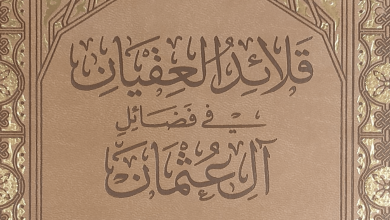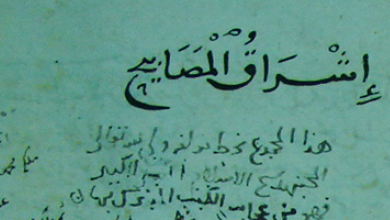The figurative Interpretations [Ta’wīlāt] of Imam Aḥmad ibn Ḥanbal (d. 241 AH) as Reported by Imam al-Ghazālī (d. 505 AH)
Imam Badr al-Dīn al-Zarkashī (d. 794 AH) said in his Al-Baḥr al-Muḥīṭ fī Uṣūl al-Fiqh (The Encompassing Sea in the Principles of Jurisprudence, 5/42-43:
قَالَ الْغَزَالِيُّ فِي كِتَابِ «التَّفْرِقَةِ بَيْنَ الْإِسْلَامِ وَالزَّنْدَقَةِ»: سَمِعْت الثِّقَاتِ مِنْ أَئِمَّةِ الْحَنَابِلَةِ يَقُولُونَ: أَحْمَدُ بْنُ حَنْبَلٍ صَرَّحَ بِتَأْوِيلِ ثَلَاثَةِ أَحَادِيثَ: أَحَدُهَا: قَوْلُهُ: «الْحَجَرُ الْأَسْوَدُ يَمِينُ اللَّهِ فِي الْأَرْضِ» . وَالثَّانِي: قَوْلُهُ عليه السلام: «قَلْبُ الْمُؤْمِنِ بَيْنَ أُصْبُعَيْنِ مِنْ أَصَابِعِ الرَّحْمَنِ» . وَالثَّالِثُ: قَوْلُهُ: «إنِّي لَأَجِدُ رِيحَ نَفَسِ الرَّحْمَنِ مِنْ قِبَلِ الْيَمَنِ» .
Al-Ghazālī said in his book “Al-Tafriqa bayna al-Islām wa al-Zandaqa” (The Distinction Between Islam and Heresy): “I heard trustworthy authorities from among the Ḥanbalī scholars saying that Aḥmad ibn Ḥanbal explicitly applied interpretation [Ta’wīl] to three ḥadīths: First, the saying: ‘The Black Stone is Allah’s right hand on earth.’ Second, his saying, peace be upon him: ‘The heart of the believer is between two fingers of the fingers of the Most Merciful.’ And third, his saying: ‘I find the breath of the Most Merciful coming from the direction of Yemen.'”
وَنَقَلَ الرَّازِيَّ عَنْ الْغَزَالِيِّ فِي كِتَابِ: «تَأْسِيسِ التَّقْدِيسِ» بَدَلَ الْحَدِيثِ الثَّانِي: «أَنَا جَلِيسُ مَنْ ذَكَرَنِي»، وَاَلَّذِي رَأَيْته فِي كِتَابِ الْغَزَالِيِّ مَا ذَكَرْنَاهُ.
Al-Rāzī quoted from al-Ghazālī in the book “Ta’sīs al-Taqdīs” (Establishing Sanctification) that instead of the second ḥadīth: “I am the companion of whoever remembers Me,” but what I saw in al-Ghazālī’s book is what we have mentioned.
قَالَ الْغَزَالِيُّ: فَانْظُرْ كَيْفَ أَوَّلَ أَحْمَدُ لِقِيَامِ الْبُرْهَان عِنْدَهُ عَلَى اسْتِحَالَةِ ظَاهِرِهِ، مَعَ أَنَّهُ أَبْعَدُ النَّاسِ عَنْ التَّأْوِيلِ. فَيَقُولُ: الْيَمِينُ تُقَبَّلُ فِي الْعَادَةِ تَقَرُّبًا إلَى صَاحِبِهَا، وَالْحَجَرُ الْأَسْوَدُ يُقَبَّلُ تَقَرُّبًا إلَى اللَّهِ تَعَالَى، فَهُوَ مِثْلُ الْيَمِينِ لَا فِي ذَاتِهِ، وَلَا فِي صِفَةٍ مِنْ صِفَاتِهِ، وَلَكِنْ فِي عَارِضٍ مِنْ عَوَارِضِهِ، فَسُمِّيَ يَمِينًا؛
Al-Ghazālī said: “Observe how Aḥmad interpreted due to the establishment of proof for him on the impossibility of its apparent [ẓāhir] meaning, despite him being the furthest of people from interpretation [Ta’wīl]. He says: ‘The right hand is customarily kissed as a means of drawing closer to its owner, and the Black Stone is kissed as a means of drawing closer to Allah the Exalted. So it is like the right hand, not in its essence, nor in any of its attributes, but in an incidental aspect of its characteristics, and thus it was named a right hand.'”
وَكَذَلِكَ لَمَّا اسْتَحَالَ وُجُودُ الْأُصْبُعَيْنِ فِيهِ حِسًّا إذْ مَنْ فَتَّشَ عَنْ صَدْرِهِ لَمْ يُشَاهِدْ فِيهِ أُصْبُعَيْنِ، فَأَوَّلَهُ عَلَى مَا بِهِ تَيَسُّرُ تَغْلِيبِ الْأَشْيَاءِ، وَقَلْبُ الْإِنْسَانِ بَيْنَ لَمَّةِ الْمَلَكِ وَلَمَّةِ الشَّيْطَانِ، وَبِهِمَا يُقَلِّبُ اللَّهُ الْقُلُوبَ، فَكَنَّى بِالْأُصْبُعَيْنِ عَنْهُمَا.
“Similarly, when the literal existence of two fingers in the heart was deemed impossible—for if one were to examine one’s chest, no two fingers would be observed—he interpreted it according to what facilitates the predominance of things. The human heart is between the inspiration of the angel and the insinuation of Satan, and through these two Allah turns the hearts, so he used the two fingers as a metaphor for them.”
قَالَ: وَإِنَّمَا اقْتَصَرَ أَحْمَدُ عَلَى تَأْوِيلِ هَذِهِ الْأَحَادِيثِ الثَّلَاثَةِ، لِأَنَّهُ لَمْ يَظْهَرْ عِنْدَهُ الِاسْتِحَالَةُ إلَّا فِي هَذَا الْقَدْرِ، لِأَنَّهُ لَمْ يَسْتَغْرِقْ الْبَحْثَ عَنْ حَقَائِقَ غَيْرِهَا، وَغَيْرُهُ كَالْأَشْعَرِيِّ وَالْمُعْتَزِلِيِّ بَحَثَهَا، وَتَجَاوَزَا فَأَوَّلَا كَثِيرًا لِقِيَامِ مَا اسْتَحَالَ كَثِيرًا.
He said: “Aḥmad limited himself to interpreting these three ḥadīths because impossibility was apparent to him only in these instances, as he did not exhaust research into the realities of others. Others, like al-Ashʿarī and the Muʿtazilī, researched them further and exceeded him, interpreting much more due to the extensive establishment of what they deemed impossible.”
وَأَنْكَرَ ابْنُ تَيْمِيَّةَ هَذَا عَلَى الْغَزَالِيِّ قَالَ: إنَّهُ لَا يَصِحُّ عَنْ أَحْمَدَ. قُلْت: وَنَقْلُ الثِّقَةِ لَا يَنْدَفِعُ، وَقَدْ نَقَلَ ابْنُ الْجَوْزِيِّ فِي كِتَابِ «مِنْهَاجِ الْوُصُولِ» عَنْ أَحْمَدَ أَنَّهُ قَالَ فِي قَوْله تَعَالَى: ﴿وَجَاءَ رَبُّكَ﴾ [الفجر: ٢٢] أَيْ أَمْرُ رَبِّك.
Ibn Taymiyya denied this attribution by al-Ghazālī, saying: “It is not authentically reported from Aḥmad.” I say: The transmission of a trustworthy authority cannot be dismissed, and Ibn al-Jawzī has reported in his book “Minhāj al-Wuṣūl” (The Path of Arrival) that Aḥmad said regarding Allah’s statement: “And your Lord has come” [Al-Fajr: 22], meaning “the command of your Lord has come.”
End of quote.
Here follows the full quote from:
فيصل التفرقة بين الإسلام والزندقة [The Decisive Criterion for Distinguishing Islam from Heresy] by Abū Ḥāmid al-Ghazālī, pp. 9-10:
**الفصل السادس : ضرورة التأويل مفروضة على جميع الفرق**
Chapter Six: The Necessity of Interpretation [Ta’wīl] is Imposed on All Groups:
اعلم أن كل من نزل قولاً من أقوال صاحب الشرع على درجة من هذه الدرجات، فهو من المصدقين.وإنما التكذيب أن ينفي جميع هذه المعاني، ويزعم أن ما قاله لا معنى له، وإنما هو مكذب محض، وغرضه فيما قاله التلبيس، أو مصلحة الدنيا.
Know that whoever interprets a statement from the statements of the Lawgiver according to one of these levels is among the believers. Disbelief is only when one denies all these meanings and claims that what was said has no meaning, and that it is pure falsehood, and that his purpose in what he said was deception or worldly benefit.
وذلك هو الكفر المحض، والزندقة.ولا يلزم كر المؤولين ماداموا يلازمون قانون التأويل كما سنشير إليه.وكيف يلزم الكفر بالتأويل، وما من فريق من أهل الإسلام إلا وهو مضطر إليه.
That is pure disbelief and heresy. Those who interpret are not to be considered disbelievers as long as they adhere to the principles of interpretation [Ta’wīl] as we will indicate. How can interpretation [Ta’wīl] necessitate disbelief when there is no group among the people of Islam except that they are compelled to it?
فأبعد الناس عن التأويل أحمد بن حنبل رحمة الله عليه.وأبعد التأويلات عن الحقيقة وأغربها أن تجعل الكلام مجازاً، أو استعارة، وهو الوجود العقلي، والوجود الشبهي.
The furthest of people from interpretation [Ta’wīl] is Aḥmad ibn Ḥanbal, may Allah have mercy on him. And the furthest interpretations [Ta’wīlāt] from literal meaning [ḥaqīqī] and the strangest of them is to make the speech metaphorical or figurative, which is the intellectual existence and the similitudinal existence.
والحنبلي مضطر إليه وقائل به، فقد سمعت الثقات من أئمة الحنابلة ببغداد يقولون إن أحمد بن حنبل رحمه الله تعالى صرح بتأويل ثلاثة أحاديث فقط.
Yet the Ḥanbalī is compelled to it and uses it, for I have heard trustworthy authorities from among the Ḥanbalī scholars of Baghdad saying that Aḥmad ibn Ḥanbal, may Allah the Exalted have mercy on him, explicitly applied interpretation [Ta’wīl] to only three ḥadīths.
أحدها: قول صلى الله عليه وسلم: (الحجر الأسود يمين الله في الأرض).
First: His saying, peace be upon him: “The Black Stone is Allah’s right hand on earth.”
والثاني: قوله صلى الله عليه وسلم: (قلب المؤمن بين إصبعين من أصابع الرحمن).
Second: His saying, peace be upon him: “The heart of the believer is between two fingers of the fingers of the Most Merciful.”
والثالث: قوله صلى الله عليه وسلم: (إني لأجد نفس الرحمن من قبل اليمن).
Third: His saying, peace be upon him: “I find the breath of the Most Merciful coming from the direction of Yemen.”
فانظر الآن كيف أول هذا ؟ حيث قام البرهان عنده على استحالة ظاهره.فيقول: اليمين تقبل في العادة تقرباً إلى صاحبها.والحجر الأسود يقبل أيضاً تقرباً إلى الله تعالى.فهو مثل اليمين، لا في ذاته، ولا في صفات ذاته، ولكن في عارض من عوارضه، فسمي لذلك يميناً.وهذا هو الوجود الذي سميناه الوجود الشبهي، وهو أبعد جوه التأويل.
Now observe how he interpreted [awwala] this, when proof was established for him on the impossibility of its apparent [ẓāhir] meaning. He says: “The right hand is customarily kissed as a means of drawing closer to its owner, and the Black Stone is also kissed as a means of drawing closer to Allah the Exalted. So it is like the right hand, not in its essence, nor in its essential attributes, but in an incidental aspect, and thus it was named a right hand.” This is the existence which we called the similitudinal existence, and it is the furthest aspect of interpretation [Ta’wīl].
فانظر كيف اضطر إليه أبعد الناس عن التأويل.
Observe how even the person furthest from interpretation [Ta’wīl] was compelled to it.
وكذلك لما استحال عنده وجود الإصبعين لله تعالى، حساً، إذ من فتش عن صدره، لم يشاهد فيه إصبعين، فتأوله على روح الإصبعين، وهي الإصبع العقلية الروحانية.أعني أن روح الإصبع ما به يتيسر تقليب الأشياء.وقلب الإنسان بين لمة الملك، ولمة الشيطان، وبهما يقلب الله تعالى القلوب، فكنى بالإصبعين عنهما.
Similarly, when he deemed it impossible for Allah the Exalted to have two fingers in a sensory manner, since one who examines his chest would not observe two fingers in it, he interpreted it [ta’awwalahu] according to the spirit of the two fingers, which is the intellectual, spiritual finger. I mean that the spirit of the finger is that by which the turning of things is facilitated. And the human heart is between the inspiration of the angel and the insinuation of Satan, and through these two Allah the Exalted turns hearts, so he used the two fingers as a metaphor for them.
وإنما اقتصر أحمد بن حنبل رضي الله عنه على تأويل هذه الأحاديث الثلاثة، لأنه لم تظهر عنده الاستحالة إلا في هذا القدر، لأنه لم يكن ممعناً في النظر العقلي، ولو أمعن لظهر له ذلك في الاختصاص بجهة فوق وغيره، مما لم يتأوله.
Aḥmad ibn Ḥanbal, may Allah be pleased with him, limited himself to interpreting [Ta’wīl] these three ḥadīths only because impossibility was only apparent to him to this extent, as he was not deeply engaged in intellectual contemplation. Had he delved deeper, the impossibility would have become apparent to him regarding the attribution of the direction of above [jiha fawq] and other matters that he did not interpret [ta’wīl].
والأشعري والمعتزلي لزيادة بحثهما تجاوزا إلى تأويل ظواهر كثيرة.
The Ashʿarī and the Muʿtazilī, due to their greater research, went beyond to interpret [Ta’wīl] many apparent [ẓāhir] meanings.
وأقرب الناس إلى الحنابلة في أمور الآخرة، الأشعرية وفقهم الله، فإنهم قرروا فيها أكثر الظواهر إلا يسيراً.
The closest people to the Ḥanbalīs regarding matters of the Hereafter are the Ashʿarīs, may Allah grant them success, for they affirmed most of the apparent [ẓāhir] meanings except for a few.
والمعتزلة أشد منهم توغلاً في التأويلات، وهم مع هذا ـ أعني الأشعرية ـ يضطرون أيضاً إلى تأويل أمور، كما ذكرناه من قوله: (إنه يؤتى بالموت في صورة كبش أملح).وكما ورد في وزن الأعمال بالميزان، فإن الأشعري أول وزن الأعمال فقال: توزن صحائف الأعمال، ويخلق الله فيها أوزاناً بقدر درجات الأعمال.
The Muʿtazilīs are more deeply engaged in interpretations [Ta’wīlāt] than them, yet with this, they—meaning the Ashʿarīs—are also compelled to interpret [Ta’wīl] certain matters, as we mentioned regarding his saying: “Death will be brought in the form of a white-and-black ram.” And as has been reported regarding the weighing of deeds with the Scale, for the Ashʿarī interpreted [awwala] the weighing of deeds, saying: “The scrolls of deeds will be weighed, and Allah will create weights in them according to the degrees of the deeds.”
وهذا رد إلى الوجود الشبهي البعيد؛ فإن الصحائف أجسام كتبت فيها رقوم تدل بالاصطلاح على أعمال هي أعراض.فليس الموزون إذن العمل، بل محل نقش يدل بالاصطلاح على العمل.
This is a reduction to the distant similitudinal existence, for the scrolls are bodies on which are written inscriptions that conventionally indicate deeds, which are accidents. Therefore, what is weighed is not the deed itself, but the place of an inscription that conventionally indicates the deed.
والمعتزلي تأول نفس الميزان وجعله كناية عن سبب، به ينكشف لكل واحد مقدار عمله، وهو أبعد عن التعسف في التأويل بوزن الصحائف.
And the Muʿtazilī interpreted [ta’awwala] the Scale itself and made it a metaphor for a means by which the measure of each person’s deeds is revealed, and this is further from arbitrariness in interpretation [Ta’wīl] than weighing the scrolls.
وليس الغرض تصحيح أحد التأويلين، بل أن تعلم أن كل فريق، وإن بالغ في ملازمة الظواهر فهو مضطر إلى التأويل، إلا أن يجاوز الحد في الغباوة والتجاهل، فيقول:
The purpose is not to validate one of the two interpretations [Ta’wīlayn], but rather for you to know that every group, even if they exaggerate in adhering to apparent [ẓāhir] meanings, is compelled to interpretation [Ta’wīl], unless they exceed the limit in stupidity and ignorance, saying:
الحجر الأسود يمين تحقيقاً.
“The Black Stone is literally [ḥaqīqī] a right hand.”
والموت وإن كان عرضاً يستحيل فينتقل كبشاً بطريق الانقلاب.
“And death, even though it is an accident, transforms and becomes a ram through the process of transformation.”
والأعمال، وإن كانت أعراضاً، وقد عدمت، فينتقل إلى الميزان، ويكون فيها أعراض هيا الثقل.
“And deeds, even though they are accidents and have ceased to exist, transfer to the scale, and there are accidents in them which are weight.”
ومن ينتهي إلى هذا الحد من الجهل، فقد انخلع من ربقة العقل.
And whoever reaches this limit of ignorance has indeed thrown off the yoke of reason.
——————————————————————————————————————–
The way of Aḥmad ibn Ḥanbal in understanding the Sifat of Allah in general was Tafwīḍ al-Maʿnā (delegating the meaning) [تفويض المعنى] and not literalism in the way of the anthropomorphists as proven from the following file pp. 20-21:
In the above file (pp. 54-55) there is also another authentically related Ta’wīl [تأويل] from Ibn Ḥanbal as transmitted by al-Khallāl in his Kitāb al-Sunna [كتاب السنة].
One may also note the way of Ibn Ḥanbal from the following links – https://www.darultahqiq.com/various-quotes-regarding-allah-attributes-ascribed-imam-ahmad-ulema/
Compiled by:
Abul Hasan Hussain Ahmed
24-4-25






